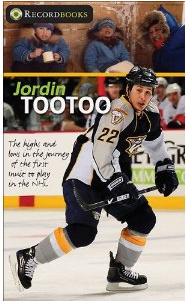
Jordin Tootoo: The highs and lows in the journey of the first Inuit to play in the NHL. By Melanie Florence. (2010, Toronto: James Lorimer & Company. Softcover. Pp. 104. $9.95. ISBN 978-1-55277-529-5.)
Melanie Florence, a writer who has published a wide variety of articles on Aboriginal people and issues, tackled the interesting and emotional story of Jordin Tootoo, the first Inuit to play in the NHL. Her first book, Jordin Tootoo, traced Tootoo’s journey from being coached by his dad on his first team in Rankin Inlet to his current role as an agitator for the Nashville Predators.
Written for juvenile readers, Florence described Tootoo’s growing up in Nunavut (Nooh-na-voot), making it easy to understand for those unfamiliar with the Native Canadian experience. Similar to the structure of the Carly Adams book Queens of the Ice (both were published by Lorimer), Florence used the text boxes to explain different aspects of both hockey and native life. Interestingly, Florence added to the mythology of the origins of hockey in one of those text boxes. She described a similar game played by the Mi’kmaq prior to the arrival of Europeans to North America, complete with animal bone skates, frozen apple pucks, and sticks made from hornbeam trees.
Overall, the book was focused on the development and determination of Jordin Tootoo to get from Rankin Inlet to the NHL. Throughout the book, the reader experienced the different stages of Tootoo’s evolution as a hockey player. Notable points from his career included:
- The first rink in Rankin Inlet was made with spaghetti to keep it from cracking;
- Tootoo shares a distinction with current teammate Shea Weber – opposing players were terrified of his slapshot;
- He played Bantam with a Native Canadian team, the Opaskwayak Cree Nation Blizzard;
- Tootoo was voted most popular player four years in a row with the Brandon Wheat Kings;
- In 2002, he won the National Aboriginal Achievement Award; and
- He changed his number to 22, in honor of his brother, Terence.
Although it was apparent that Tootoo worked hard to be able to realize his dream of playing in the NHL, sometimes it was incredibly difficult for him to continue advancing. During his time in juniors, Tootoo experienced anti-Aboriginal racism for the first time. He would get homesick, and moving south into larger cities was often a culture shock.
Ultimately, a singular tragic moment would have a tremendous affect on his life – the suicide of his older brother Terence in 2002. Emotional topics, such as suicide are not often discussed in juvenile literature. Florence handled these weighty topics with both a sensitivity and well as in the capacity of an educator, explaining their difficult nature without a preachy tone.
Most hockey fans are aware of Tootoo’s recent experience with the NHL / NHLPA substance abuse program for alcohol abuse. It was during this time that more people became aware of the story of Terence Tootoo and the tragic affects suicide has on those left behind. Jordin showed courage in getting help for his problems by way of alcohol treatment centers and, if the book had been written later than it was, one can be sure Florence would have handled this situation with the tact she used in the rest of the book.*
Overall, Tootoo’s story was inspirational for both children and adults. He showed that despite setbacks and adversity, one can achieve their dreams with hard work. Nashville Predators’ fans will not be surprised that Tootoo was voted the most popular player with the Wheat Kings, as he is probably the most popular player skating for the Predators today. His recent return to the ice was celebrated in Nashville and Number 22’s jersey t-shirts are incredibly difficult to come by in the Pro Shop at Bridgestone Arena.
Rebecca Dobrinski
*I hope readers understand that I am not excusing Tootoo’s alcohol abuse problems, nor am I trying to justify them. In light of his recently completing rehab, his whole story becomes more poignant. As Jordin’s mother, Rose Tootoo, told the CBC News, “Everybody makes mistakes. So if you think you have a problem, don’t be afraid, like I say. Go out and get help.” (Alaska Dispatch, December 31, 2010) – an important lesson to learn from Mrs. Tootoo.
I asked my sister-in-law, a fourth grade teacher in Birmingham, Alabama, to read and add her thoughts on Melanie Florence’s Jordin Tootoo:
As a fourth grade teacher and someone who is new to the hockey world (what can I say, I am in a football-dominated state), I found Ms. Florence’s book very easy to read for both children as well as “newbies” learning the sport. To illustrate the point, I completed the book in about 45 minutes while at my family’s house for dinner! Ms. Florence’s writing style flowed easily and her explanations of various hockey-lingo were easy to understand.
Ms. Florence had an eloquence in her words that made the reader feel as though they are old pals with Tootoo. I found myself cheering for him when he made it to the NHL, as well as feeling completely devastated when Terence passed away. While I was a Jordin Tootoo fan since I watched my first Preds game, I feel that I would have still become a fan of his after reading this book even if I did not know anything about hockey beforehand.
I am excited to share Jordin Tootoo’s story with my fourth graders and hope that they begin to love hockey as I do!
Michelle Mathis Dobrinski